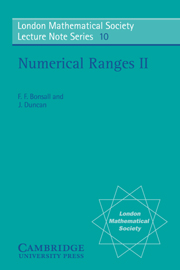Introduction
Published online by Cambridge University Press: 05 April 2013
Summary
This volume is a sequel to Numerical ranges of operators on normed spaces and of elements of normed algebras, which is here denoted by NRI. Although it appeared in 1971, NRI was written in 1969, and since then the subject has made vigorous progress, reaching a high point with the Conference on Numerical Ranges, held in Aberdeen, July 1971. This conference gave us an unusually good opportunity to see the scope of the subject, which is much less specialized than the title might suggest.
A comparison of the present volume with NRI will show that the theory of numerical ranges has become immensely richer both in depth and in width. The contents have been grouped into three chapters: 5. Spatial numerical ranges; 6. Algebra numerical ranges; 7. Further ranges.
In Chapter 5 we are mainly concerned with the improvement of the Bishop-Phelps theorem due to Bollobás [115] and with applications of this useful tool. We also give the remarkable theorem of Zenger [78] on the inclusion of the convex hull of the point spectrum in the spatial numerical range V(T), and the equally remarkable results of Crabb [136] and Sinclair [202] concerning points of Sp(T) ∩ ∂V(T).
NRI contained an inequality (Theorem 4. 8) relating the norms of iterates to the numerical radius and a remark that this inequality had been proved to be best possible in a strong sense. Chapter 6 contains a systematic approach to such best possible inequalities through the theory of the extremal algebra Ea(K) which has been developed by Bollobás [117] and Crabb, Duncan, and McGregor [134], Here the numerical range comes into contact with interesting function theoretic ideas.
- Type
- Chapter
- Information
- Numerical Ranges II , pp. v - viiiPublisher: Cambridge University PressPrint publication year: 1973

